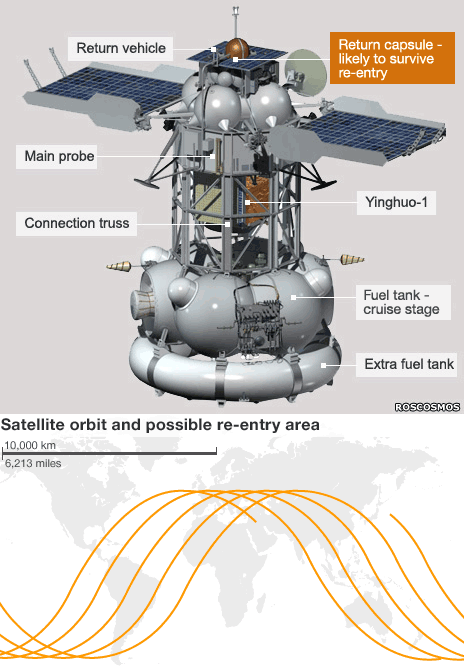
Phobos-Grunt, the Russian’s failed Mars probe, is about to fall back to Earth – quite probably on Sunday.
Phobos-Grunt spacecraft has been losing altitude rapidly in recent days and will soon be pulled into the top of the atmosphere where it will be destroyed.
The probe weighed some 13 tons at launch, but very little of this mass should make it through to the surface.
Russian space agency (Roscosmos) estimates suggest only 200kg will survive the fiery plunge.
Orbital debris experts say there are large uncertainties in predicting re-entry events and it is currently not possible to forecast precisely when or where on Earth the final descent will occur.
“The major uncertainty for prediction is the atmospheric density the spacecraft encounters in orbit, but it’s also due to the orientation of the vehicle as it comes in,” explained Prof. Richard Crowther, the UK Space Agency’s chief engineer.
“It can very quickly tumble and if pieces break off – that all changes the trajectory and where debris might impact.”
This is the third high-profile spacecraft re-entry in four months, following the return in September of the American UARS satellite and the German Rosat telescope in October. Both fell over the ocean.
With so much of the Earth’s surface covered by water, there is every chance Phobos-Grunt will do the same.
The mission was supposed to be the most exciting Russian space science venture in decades – an audacious bid to scoop up rocky fragments from the Martian moon Phobos and bring them back for study in Earth laboratories.
Phobos-Grunt was successfully launched on 8 November, entering a “parking orbit” some 345km above the Earth. But the spacecraft then failed to push on to the Red Planet as planned.
For some reason, its big boost engine did not fire. Attempts to contact the spacecraft and diagnose the fault have proved fruitless.
Both professional and amateur tracking groups have been trying to work out when it will fall out of the sky, and many of their estimates are clustering around late Sunday (GMT).

The spacecraft’s rate of descent is being monitored by radar and the tracking groups will be using this information to try to narrow the uncertainties as the weekend progresses.
A lot of attention has focused on the amount of fuel that Phobos-Grunt is carrying.
Out of the total launch mass of more than 13 tons, in excess of 10 tons was the fuel needed to complete the mission.
Phobos-Grunt’s tanks were filled with the propellants Unsymmetrical DiMethylHydrazine (UDMH) and Dinitrogen TetrOxide (DTO), both of which are toxic.
But, crucially, the tanks are made of aluminium, which has a relatively low melting temperature.
Analysts are confident the tanks will rupture and their contents will be destroyed or dispersed long before any debris can reach the surface.
“Depending on when something breaks up and what it’s made of and how it comes away from the main vehicle, it can either burn up or survive re-entry,” said Prof. Richard Crowther.
“In the case of Phobos-Grunt, it’s a flying fuel tank in many respects, and so most of the mass is fuel which should explode.”
The Russians have had a torrid run of space failures recently, leading the head of the country’s space agency to wonder even if saboteurs were at work.
Western countries, which use Russian rockets to launch their satellites, are just worried though that some systematic failures have started to appear in what has traditionally been a highly regarded space industry.
With their own opportunity to go to Mars now lost, the Russians may decide to put their future interplanetary efforts into joint ventures with the Americans and the Europeans. The Russians have an offer from the US and Europe to join the ExoMars missions to the Red Planet in 2016 and 2018.